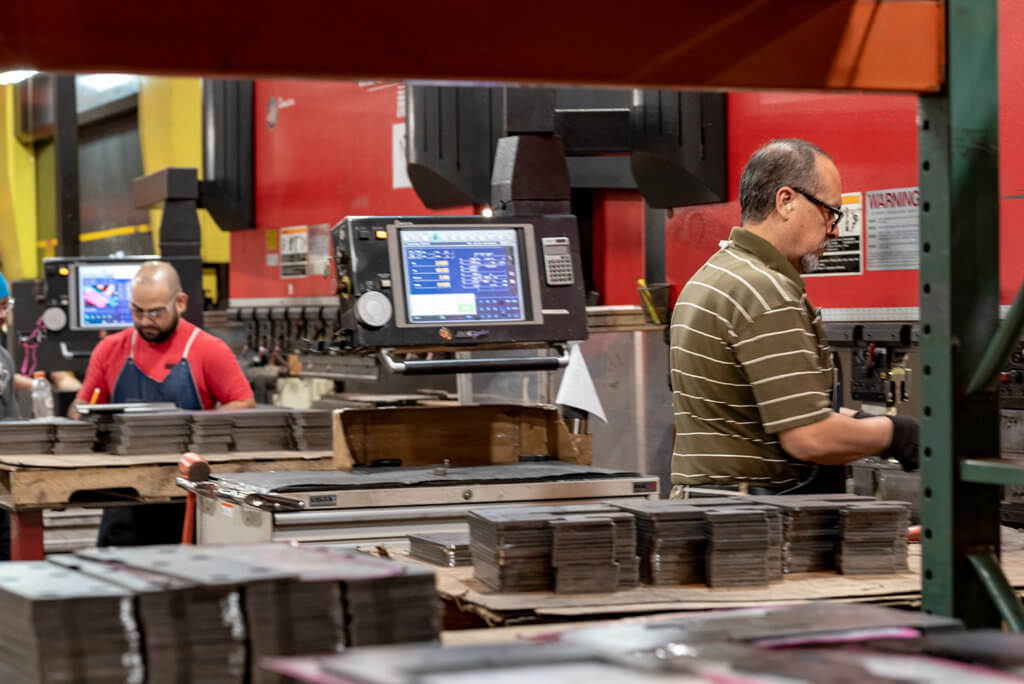Safety is Job Number One at Laser Precision
May 08, 2019
In a previous article, we discussed 5S Methodology and how Laser Precision has formalized our continuous improvement program. Many organizations think in terms of a 6S agenda, with the final element being Safety. We decided to separate our safety program so that risk issues have management’s full and undivided attention.
The Basics
Naturally, we have always made sure that each employee has the proper personal protective equipment (PPE) such as safety shoes, welding helmets, gloves, etc. Each person who drives a fork lift has to have their certification up to date, and everyone on the shop floor (visitors included) is expected to wear eye protection at minimum. At orientation, the first step for new operators is to view a safety operation video on the machine they will be using. We also have safety tips (such as how much you can lift unassisted) posted around the facility.
This is all pretty fundamental, but you’d be amazed how many companies do not take even these simple precautions. Our standards are much higher. Our objective is to provide our operators with everything they need to do the best job they can in a safe and comfortable manner.
A Good Start
Implementation of the 5S Methodology has given us a good template to follow for the new safety program. If we review the first three elements, their value in creating a safe working environment is readily apparent.
- Sort:Examine all tools, materials, equipment, etc. in a work area and remove everything not required to do the job.
- Set in Order:Put all necessary items in the optimal place for fulfilling their function.
- Shine:Clean and inspect the workplace, tools and machinery on a regular basis.
There are a million ways to get hurt on any shop floor, and while no one can think of everything, eliminating a cluttered and messy work area is a good start. But to follow through on our safety program, we needed to apply the final 2 “S” elements:
- Standardize:Establish and schedule the processes used for the first three “S” practices.
- Sustain:Continue the processes consistently until it becomes second nature.
Active Safety Activities
Our first step in our efforts to standardize and sustain safety was to appoint Jenny Torres as our full-time Safety Manager. When she is not involved in Purchasing operations, she walks the floor, looking for potentially hazardous situations or violations of current policy. Jenny gives a report that our monthly Management Review Meeting on any long-term safety initiatives she feels need to be discussed.
She brings new issues and ideas from the floor and presents them to the team so remedies can be standardized. Naturally, if she sees a potentially dangerous situation, she notifies the supervisor of the department immediately. All employees are encouraged to do the same.To make sure nothing is overlooked during the monthly internal checks, safety audits are conducted by an outside 3rdparty semi-annually.
Putting Out the Word
Instead of sending out a safety memo and assuming everyone will read it, safety directives are delivered during a monthly quality/safety performance meeting which is held with all employees. This way, every single person in the company gets the message at the exact same time. They are given reminders from the previous month, new safety issues they need to know about, and goals for the coming month. We feel this regularly scheduled meeting format helps deliver the “sustain” element of our safety 5S approach.Our President, Jeff Adams, ends every employee meeting with the reminder that “There is not a single job in this building that is more important than your health and safety.”
Initiating Safety Measures
Along with our active awareness program, we are always looking for safety technology upgrades that can passively safeguard our operators’ health. For example, we recently retrofitted our press brakes with a presence sensing device(PSD) that works by employing a system of lasers around the die. If a foreign object is detected, the machine will immediately retract the die without further operator intervention.
Safety has always been an important factor in the way our business is run. A manufacturing environment is always fast-paced and dynamic. Fabrication equipment is big, heavy, fast and/or hot and sharp. Our employees are trained to keep their “head in the game” at all times when on the floor.
Going above and beyond to ensure the physical well-being of our employees is the only way we know how to conduct our business. Employees, suppliers, and customers should know safety means everything to us, because at the end of the day, we all want to return home to the things that matter most.





